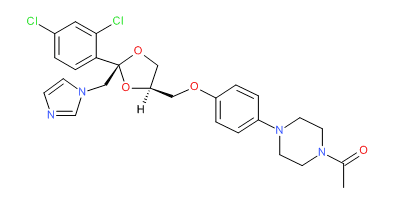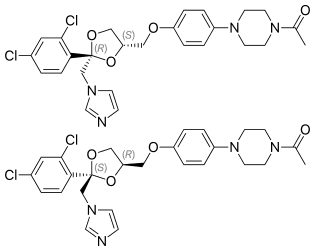Trade names Nizoral MedlinePlus a682816 Molar mass 531.431 g/mol | AHFS/Drugs.com Monograph License data US FDA: Ketoconazole CAS ID 65277-42-1 | |
 | ||
Pronunciation /ˌkiːtoʊˈkoʊnəˌzoʊl, -zɒl/ Pregnancycategory AU: B3US: C (Risk not ruled out) | ||
Ketoconazole (INN, USAN, BAN, JAN) is a synthetic imidazole antifungal drug used primarily to treat fungal infections. Ketoconazole is sold commercially as a tablet for oral administration (although this use has been discontinued in a number of countries), and in a variety of formulations for topical administration, such as creams (used to treat tinea; cutaneous candidiasis, including candidal paronychia; and pityriasis versicolor) and shampoos (used primarily to treat dandruff—seborrhoeic dermatitis of the scalp).
Contents
- Topical antifungal
- Systemic antifungal
- Antiandrogenic and antiglucocorticoid
- Veterinary
- Mechanism of action
- Administration and absorption
- Resistance
- Hair loss
- Adverse effects
- Chemistry
- History
- References

The less toxic and generally more effective triazole antifungal agents fluconazole and itraconazole are usually preferred for systemic use. In 2013 the European Medicines Agency's Committee on Medicinal Products for Human Use (CHMP) recommended that a ban be imposed on the use of oral ketoconazole for systemic use in humans throughout the European Union, after concluding that the risk of serious liver injury from systemic ketoconazole outweighs its benefits. The oral formulation of ketoconazole was discontinued in Australia in 2013 and in China in 2015.

Topical antifungal

Topically administered ketoconazole is usually prescribed for fungal infections of the skin and mucous membranes, such as athlete's foot, ringworm, candidiasis (yeast infection or thrush), jock itch, and tinea versicolor. Topical ketoconazole is also used as a treatment for dandruff (seborrheic dermatitis of the scalp) and for seborrheic dermatitis on other areas of the body, perhaps acting in these conditions by suppressing levels of the fungus Malassezia furfur on the skin.
Systemic antifungal

Ketoconazole has activity against many kinds of fungi that may cause human disease, such as Candida, Histoplasma, Coccidioides, and Blastomyces (although it is not active against Aspergillus). First synthesized in 1977, ketoconazole was the first orally-active azole antifungal medication. However, ketoconazole has largely been replaced as a first-line systemic antifungal medication by other azole antifungal agents, such as itraconazole, because of ketoconazole's greater toxicity, poorer absorption, and more limited spectrum of activity.

Ketoconazole is used orally in dosages of 200 to 400 mg per day in the treatment of superficial and deep fungal infections.
Antiandrogenic and antiglucocorticoid
The side effects of ketoconazole are sometimes harnessed in the treatment of non-fungal conditions. While ketoconazole blocks the synthesis of the sterol ergosterol in fungi, in humans, at high dosages (>800 mg/day), it potently inhibits the activity of several enzymes necessary for the conversion of cholesterol to steroid hormones such as testosterone and cortisol. Specifically, ketoconazole has been shown to inhibit cholesterol side-chain cleavage enzyme, which converts cholesterol to pregnenolone, 17α-hydroxylase and 17,20-lyase, which convert pregnenolone into androgens, and 11β-hydoxylase, which converts 11-deoxycortisol to cortisol. All of these enzymes are mitochondrial cytochrome p450 enzymes. Based on these antiandrogen and antiglucocorticoid effects, ketoconazole has been used with some success as a second-line treatment for certain forms of advanced prostate cancer and for the suppression of glucocorticoid synthesis in the treatment of Cushing's syndrome. However, in the treatment of prostate cancer, concomitant glucocorticoid administration is needed to prevent adrenal insufficiency. Ketoconazole has additionally been used, in lower dosages, to treat hirsutism and, in combination with a GnRH analogue, male-limited precocious puberty. In any case, the risk of hepatotoxicity with ketoconazole limits its use in all of these indications, especially in those that are benign such as hirsutism.
Veterinary
This medication is also sometimes prescribed by veterinarians for use on pets, often as unflavoured tablets that may need to be cut to smaller size for correct dosage.
Mechanism of action
As an antifungal, ketoconazole is structurally similar to imidazole, and interferes with the fungal synthesis of ergosterol, a constituent of fungal cell membranes, as well as certain enzymes. As with all azole antifungal agents, ketoconazole works principally by inhibiting the enzyme cytochrome P450 14α-demethylase (CYP51A1). This enzyme participates in the sterol biosynthesis pathway that leads from lanosterol to ergosterol. Lower doses of fluconazole and itraconazole are required to kill fungi compared to ketoconazole, as they have been found to have a greater affinity for fungal cell membranes.
As an antiandrogen, ketoconazole operates through at least two mechanisms of action. First, and most notably, high oral doses of ketoconazole (e.g. 400 mg three times per day) block both testicular and adrenal androgen biosynthesis, leading to a reduction in circulating testosterone levels. It produces this effect through inhibition of 17α-hydroxylase and 17,20-lyase, which are involved in the synthesis and degradation of steroids, including the precursors of testosterone. Due to its efficacy at reducing systemic androgen levels, ketoconazole has been used with some success as a treatment for androgen-dependent prostate cancer. Second, ketoconazole is an androgen receptor antagonist, competing with androgens such as testosterone and dihydrotestosterone (DHT) for binding to the androgen receptor. This effect is thought to be quite weak however, even with high oral doses of ketoconazole.
Ketoconazole, along with miconazole, has been found to act as an antagonist of the glucocorticoid receptor.
Administration and absorption
When administered orally, ketoconazole is best absorbed at highly acidic levels, so antacids or other causes of decreased stomach acid levels will lower the drug's absorption. Absorption can be increased by taking it with an acidic beverage, such as cola. Ketoconazole is very lipophilic and tends to accumulate in fatty tissues.
Resistance
Resistance to ketoconazole has been observed in a number of clinical fungal isolates, including Candida albicans. Experimentally, resistance usually arises as a result of mutations in the sterol biosynthesis pathway. Defects in the sterol 5-6 desaturase enzyme reduce the toxic effects of azole inhibition of the 14-alpha demethylation step. Multidrug-resistance (MDR) genes can also play a role in reducing cellular levels of the drug. As azole antifungals all act at the same point in the sterol pathway, resistant isolates are normally cross-resistant to all members of the azole family.
Hair loss
Ketoconazole shampoo in conjunction with an oral 5α-reductase inhibitor has been used off label to treat androgenic alopecia. The antifungal properties of ketoconazole reduce scalp microflora and consequently may reduce follicular inflammation that contributes to alopecia.
Limited clinical studies suggest ketoconazole shampoo used either alone or in combination with other treatments may be useful in reducing hair loss.
At least one study has been performed showing that ketoconazole may be useful in temporarily reducing erectile function in postoperative penile surgery patients.
Adverse effects
It is a pregnancy category C drug because animal testing has shown it to cause teratogenesis when administered in high doses. Recently, the administration of systemic ketoconazole to two pregnant women for treatment of Cushing's syndrome was reported to have no adverse effects, but this small sample precludes drawing any meaningful conclusions. A subsequent trial in Europe failed to show a risk to infants of mothers receiving ketoconazole.
On July 2013, the U.S. Food and Drug Administration (FDA) issued a warning that taking ketoconazole orally can cause severe liver injuries and adrenal gland problems. It recommends Nizoral oral tablets should not be a first-line treatment for any fungal infection. Nizoral should be used for the treatment of certain fungal infections, known as endemic mycoses, only when alternative antifungal therapies are not available or tolerated.
The topical formulations of Nizoral have not been associated with liver damage, adrenal problems, or drug interactions. These formulations include creams, shampoos, foams, and gels applied to the skin, unlike the Nizoral tablets, which are taken by mouth.
Chemistry
Ketoconazole is a racemic mixture consisting of cis-(2S,4R)-(−) and cis-(2R,4S)-(+) enantiomers. The cis-(2S,4R) isomer was more potent in inhibiting progesterone 17α,20-lyase than its enantiomer (IC50 values of 0.05 and 2.38 μM, respectively) and in inhibiting 11β-hydroxylase (IC50 values of 0.152 and 0.608 μM, respectively). Both isomers were relatively weak inhibitors of human placental aromatase.
History
Ketoconazole was discovered in 1976 at Janssen Pharmaceuticals.
